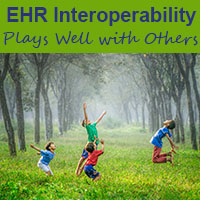Posted By Amanda Girard On October 27, 2021
EHR Interoperability: Playing Well with Others

“Plays well with others” is a phrase most of us remember as a desirable benchmark for success as children. It is also a benchmark for success in Electronic Health Record (EHR) systems. EHR interoperability is important for supporting whole-person care because it supports seamless information sharing between disparate services, providers and systems. EHR interoperability allows providers and program leaders to exchange patient data, Social Determinants of Health (SDOH) information, get reporting for program funding, and watch out for patient safety. Additionally, when systems are interoperable, the attending physicians and clinical staff experience less burnout.
WHAT is EHR Interoperability?
“Procuring Interoperability” by National Academy of Medicine (NAM) defines interoperability, stating that the goal for optimization of investment in health IT is this:
“ …information from multiple sources, devices, and organizations across the care continuum must be able to flow at the right time, to the right party, for the right patient.”
The National Academy of Medicine says that EHR interoperability is the goal for both sides of the healthcare coin, providers and patients, because “digitized information opens opportunities for patients and clinicians to have a fuller and more timely picture of an individual’s health and health care experience.”
Centers for Medicare & Medicaid Services (CMS) rebranded what was previously termed Meaningful Use as Promoting Interoperability. CMS says the goal of promoting EHR interoperability is multi-dimensional:
“to … make it more flexible and less burdensome; emphasize measures that require the exchange of health information between providers and patients, and incentivize providers to make it easier for patients to obtain their medical records electronically.”
Meaningful Use Certification as an interoperable system requires EHRs to hit reporting measures for Electronic Prescribing, Health Information Exchange (HIE), provider to patient exchange, and Public Health and Clinical Data Exchange. The certification also gives points to EHRs that support the Query of Prescription Drug Monitoring Program (PDMP), and support Electronic Referral Loops by receiving and reconciling health information.
HOW Interoperability Improves Care
The West Health Institute estimated in 2013 that interoperability “promotes increased efficiency, lowers costs, and better quality of care” through four main fronts:
- reducing adverse events because of safety interlocks ($1.9 billion);
- reducing redundant testing ($1.5 billion);
- reducing clinician time spent manually entering information ($12 billion); and
- shortening length of stay through more timely transmission of critical information such as lab results ($18 billion).
EHR interoperability is important for patient safety, reducing burnout on clinicians, and lowering healthcare costs that increases access to treatment.
WHAT EHR Interoperability Means to YOU
When all service providers, programs and information sharing systems have access to the same real-time state of the body, mind, prescriptions, and Social Determinants of Health metrics on the same patient; the definition of interoperability is realized. If your healthcare agency is trying to increase patient care to support initiatives in Public Health 3.0, Social Determinants of Health (SDOH), Behavioral Health Integration (BHI) and other methods of realizing “whole person care” make sure your EHR supports that. EHR interoperability is the cornerstone of how healthcare IT supports treating the whole person because it provides a vehicle for collaboration, exchange and communication that aids care providers in making that possible.



